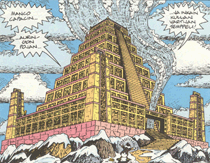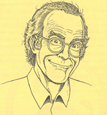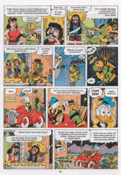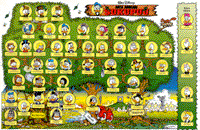![]()
Long Introduction
The information in this page has been collected from many different sources, mainly from different web sites. It has a quite lot of small details about Don Rosa for those Rosa-fans, who want to know everything about him. If you only want to know basics of him, you should read the short introduction. In the end you'll find the most important information about him in the Fact box.
Family and Childhood
Don Rosa's father's side family is Iitalian. Don's father, Hugo Rosa, was born in Maniago, which is a small village near Venice in North-Italy. He was still just a little boy when his family moved to United States in 1915 just before the World War I. Don's mother's, Chilistina Titiano's, family had already lived there many years. Her father was German and her mother had Scottish and Irish relatives. According to Don there still lives many Rosas in North-Italy, but he's the last Rosa in America.
 Detail from Captain Kentucky comic strip |
Don Rosa was born in June the 29th in 1951 and grow up in St. Matthews, Kentucky and later in U.S. 42's home. He had a traditional American education so he never learned to speak Italian. His immigrant grandfather Gioachino "Keno" Rosa had established a tile company in 1905 called Keno Rosa Company, that Hugo (Don's father) later inherited. |
Don started to draw right after he got out of his cradle and his parents needed to fill the balloons. But the story was always in the main part and Don never really liked the drawing itself. He saw them as sort of movies, because he was also a big movie-fan. His characters were always until high scool's eight or ninth grade just little men mostly called Holey and Joe. By time the stories got better but the drawings stayed the same for a long time, because they weren't that important, they just advanced the story.
Don's 11 years older big sister Diana had many comic books, that some were Dell-publishing company's Disney comic books. Don read these comics and this is how he got to read Carl Barks' stories from 1949 and forwards. It's these, his big sisters comics how he became a great Barks-fan. Diana's collecting frenzy is probably one reason why Don also has a collector's personality. Later, when he was a little over ten, Don throw out all of his sisters and his own comic books except two of his favourites: Four Color #386, that was also the first Uncle $crooge -comic book (although Don didn't know that) and that had the story Only a Poor Old Man, and a comic book, that contained the Colden Helmet-story. Later, Don collected back all of the comic books that he had thrown away, but of couse, he didn't get the exact same copies.
All the schools that Don went except some college's art history lectures were boys' schools: a private school Saint Thomas Accquines Prepaparaty (classes 1-8), Catholic boys' school Saint Xavier High School Louisville and engineering school for boys. Even during the lessons Don draw satire comics about what was being teached. But he never took art classes in any of his schools.
When Don was in college, it's newspaper, Kentucky Kernal, wanted to publish a political satire comic and asked Don (who was already it's cartoonist) to do it. Don did for a one semester a daily comic strip called Pertwillaby Papers, in which the hero, Lancelot Pertwillaby, enrolled to college without paying for it. Lancelot is Don himself and that's why he likes the character so much. After the paper's editor changed to one who agreed to publish adventure comics, Don put his comic's characters into a treasure hunt-story, which's plot he later used in his first duck story, The Son of the Sun. The story was called Lost in (an alternative section of) the Andes. |
After graduating from college in 1973 with the Barchelor of arts degree Don went working for his family business and started working from the bottom as a floor tiler. The intention was that later he would be the boss of the company. In his spare time Don continued his Pertwillaby Papers-comics, but this time he made it for The Rocket's Blast Comiccollector-fanzine. In all he made three stories for it from which the last, Knighttime, remained unfinished. It was published in 1979.
Already in the same year Don began making every Saturday a Sunday-size comic strip to a local newspaper, Louisville Times. It was called Captain Kentucky and it was a parody of super hero comics, as Don didn't really like super heroes. Captain Kentucky himself is Lance Pertwillaby's super hero alter ego. After making the strip for 150 episodes or three years, he ended it, because he only got very little money for it and he thought that it wasn't worth it anymore. So, he packed away his drawing table and didn't draw a single line untill year 1986.
After ending Captain Kentucky, Don made one more episode of Knighttime, which begins when Lance wakes up from a nightmare and realizes that his super hero career had just been a dream. RBCC never published it.
In 2001 Norwegian Gazette Bok published two harcover books under the name The Don Rosa Archives: The Pertwillaby Papers and The Adventures of Captain Kentucky. The books are in English and they can be ordered from here, but in Finland they can also be found from Akateeminen kirjakauppa and Suomalainen kirjakauppa.
The Son of the Sun
One day in 1986 Don Rosa saw in a window of a small comic shop a Gladstone comic book, the first American comic book that contained Disney-characters after the 1970's. He immediately saw that the comic book was produced by people who felt same kind of respect towards the ducks like he did. In fact, he believed that the cover, which was drawn by Daan Jippes, was to him unknown Carl Barks' drawing, because Jippes' drawing style was, and still is surprisingly like Barks'. Anyway, inspired by this Don realized, that he had almost subconsciously been waiting for something like this. So, he called Byron Erickson, who was Gladstone's editor at the time and informed Byron that it was his destiny to write and draw an Uncle $crooge-adventure. Byron agreed and on the next day Don started making his first Duck story, Son of the Sun.
Disney and Egmont
In 1989 Don stopped working for Gladstone, because Disney wouldn't let it return to the artists their stories' originals anymore. As a freelancer Don couldn't accept this kind of practice and besides he got a part of his livelihood by selling he's originals. When he couldn't do that anymore, he's incomes were too small. He was now out of job, but not for long, because the publisher's of an American Disney childeren's comic book DuckTales offered Don a job right after he's resignation. Because he really now was unemployed, and he was offered a pay much bigger than his previous ones, he did write a script to a one DuckTales -story (Back in a Time for a Dime!). He might have even continued working for DuckTales, but he had troubles getting his pay, and in addition some editor of the magazine changed his script destroying many of Don's jokes.
Don's next job was a TV-serie's script writer. Disney Television had already a year before offered him a job. So, now he accepted the offer, but the the show where he had been offered a job from, DuckTales, had already been stopped, so Don ended up writing the new TaleSpin -series. He only wrote the three first animated episodes (although not first aired). He resinged after Egmontin offered him a job for two reasons. First: he was never sure if he got his pay, although when he did it was a big one. Second: as a TV-script writer he only did a small part of the whole show's work, and he wanted to be responsible for he's works alone, in good and in bad..
When he was still working as a script writer Don found out, that also Danish Egmont (former Gutenberghus) had published reprints of his stories and wanted more of them. He had also in years 1986-1989 done Disney-comics to a Dutch publishing firm Oberon, that he had mostly only drawn. He made them between his Gladstone works, because it's budget was too small that he could've have made stories to them all the time. Oberon, too, was interested in his stories. So, now he had the chance to choose between Egmont and Oberon. He choose Egmont, because it had a bigger budget, and because of it's great popularity could pay a good salary.
About the same time Disney had taken publishing comics from Gladstone and it, too, wanted Don's comics. But because Disney wouldn't give him even the most primitive rights of freelancer, Don stayed at Egmont. Although he did a one story for Disney (The Money Pit) as to tell that if they would change their contract, he could work for them.
Don still mostly makes his stories for Egmont eventhough he is a freelancer and has also done three stories for French Picsou Magazine: The Coin, Attaaaaaack! and The Sharpie of the Culebra Cut mostly because Egmont didn't want them. Egmont has told Don that they dont want anymore stories of Scrooge's youth. Don has also made many PinUps (one page drawings) for Picsou.
A Week in Don Rosa´s Life
In weekends Don doesn't make any stories, but still answers to messages he receives, except on Saturdays, when he only replies to them in the morning. Other than that he does his houseworks and rests.
The Making of Comics
A story drawn (and written) by Don Rosa can be easily recognized: it's really accurately and carefully drawn and full of funny details. The multitude of details is due to that in his youth Don read many MAD-magazines, that had Harvey Kurtzman's and Will Elder's stories which were full of grazy details. Partly it comes from his engineering education and partly because he just wants his drawings to be accurate. Don also always checks the backgrounds of his stories, because he wants them to be as accurate and as real as possible, and it can take few weeks if it's a long adventure story. All of his stories (except some special occasions) take place in 1950's which is when he himself as a kid read Barks-stories, and besides, otherwise Scrooge would be over 130 years old! This being, according to Don, Scrooge died in 1967 when he was 100 years old.
Don is a huge Carl Barks-fan and admirer and in his first duck stories he imitated the duck's positions from Barks' stories. He has even drawn through some of Barks' panels for his The Lifes and Times of $crooge McDuck-series. He has also done sequels to some of Barks' legendary stories, for example Renturn ot Xanadu, War of the Wendigo and The Lost Charts of Columbus.
When drawing comics Don uses coated, three-layer Strathmore paper, that is very expensive, at least seven different pens and of course an eraser. The pens he use aren't actually pens of a professional comic artist: he uses engineering pens, calligraphy pens, ect. He has also mentioned that he used PigmaMicron 01 (Sakura) pens in all the stories that Gladstone published [Don has said lately that this information is not true]. He also has templates that are from his college times and that also are devices that professional comic artist would never use. But Don uses them when drawing ducks and some round items like coins. He also has an illuminated desk for accurate details.
When Don knows how many pages his story contains, he starts making it from the end, because he knows how it ends. He draws it from the end towards the beginnnig about to the center of the story untill he begins to do it from beginning to end. Somewhere in the middle he combines the beginning and end with couple of pages. This way he can concentrate to the most important parts of the story: the beginning and the end.
Don sometimes hides Mickey Mouse-pictures into his stories as a joke, because he doesn't especially like Mickey and thinks he has no real personality, but is just an empty picture and Don never plans to do a Mickey-story. But he does think Floyd Gottfredson's Mickey-stories are very successfuled. He also hides in almost all of his stories' (and single pictures) splash panel (the first panel of the story) the text D.U.C.K. which means Dedicated to Unca Carl from Keno. At first he just wrote it into sight in his first stories but Gladstone thought it as a signature so they removed it and ever since then Don has been hiding it.
Don's favourite character in Scrooge, because he's so versatile and he can be put into many different kind of stories: he can fight against the Beagle Boys or Magica de Spell for his fortune (or first dime); he can compete with someone else rich, like Flintheart Glomgold; he can be in a treasure hunt or he can tell a story about his youth. Scrooge doesn't collect money to buy things, he gets his joy for the adventure and for achieving the money himself. In most of Don's stories Scrooge is the main character.
Fame
The biggest (and most respected) work of Don Rosa is 12-part The Life and Times of $crooge McDuck-series, that tells Scrooge's life story from ten years old boy to the Chistmas Day in 1947 when he the first time met Huey, Dewey and Louie. Don made the series in 1991-1993 and the stories were published in Finland (except the two first ones) in years 1992-1994 and later in 1997 as a book. He got the work because Egmont was planning such a series and Egmont Comic's editor (and a good friend of Don) Byron Erickson knew that he liked Scrooge, so he offered the job for him. Don has also made four b-parts to it: Hearts of the Yukon, The Vigilante of Pizen Bluff, The Cowboy Captain of Cutty Sark and the newest The Sharpie of the Culebra Cut, that he made for French Picsou Magazine, because Egmont didn't want to publish b-parts anymore. Some people also think the stories Of Times, Ducks and Destinies and The Ducthman's Secret also belong to the series. |
|
The most famous single drawing by Don Rosa is probably Duck Family Tree (RD 9400), that was published in Finland originally with Aku Ankan Taskukirja's issues 168 and 169 and later with Roope Ankan elämä ja teot- book and in Aku Ankka's number 30/99. Originally Don intented to do a story about duck's relationships but then his editor asked if he could draw a family tree and when it was done there was no need for the story. |
The Finnish Disney-publisher, Helsinki Media has had from the year 1995 a habit to publish a new Rosa-book every second year, and so far the has been published four hardcover Don Rosa-books: Kadonneen kirjaston vartijat, Roope Ankan elämä ja teot, Sammon salaisuus and Temppeliherrojen kätketty kruunu. In Finland Aku Ankka is the only comic book that publishes Don Rosa' stories except for Roope-setä's special issue 12B/1991.
Don Rosa has won two Will Eisner Awards that are the comic world's Oscars: in 1995 for best continuing story (The Life and Times of $crooge McDuck) and in 1997 as the best humour writer/artist.
Don Rosa is the most popular Disney-author who is still working, although they don't publish any Disney-comics in his home country, United States, anymore. His the only one besides Carl Barks (and Walt Disney, of couse) whose name is mentioned in Disney comic books' covers when his stories are published in them (at least in Finland). Although in the States even his neighbor doesn't know what he does for living, when his in Europe, his treated like a rock star.
Miscellaneous
Besides Carl Barks Don also likes the comics of Alex Raymond, Burne Hogart, Hal Foster, Will Eisner and Walt Kelly and Harvey Kurtzman's and Will Elder's MAD-comics. But Barks' Scrooge stories are the best comics on his opininon.
At the moment Don lives in Louisville (althought he actually lives a bit closer to Fisherville), Kentucky with his wife, three basset dogs and Gyro-cockatoo. They live in a log cabin, that is located in the middle of twelve hectare farm, which Don at one time bought, although they don't do any farm work. Their closest neighbour lives out of sight behind the next hill.
Don has two cars: 1938 Nash Lafayette Deluxe and 1948 Dodge Custom-6. He has renovated both of the cars himself but he mostly drives with the Dodge. His number plate reads COMICS, which he got already in 1977. Ann drives a BMW.
As earlier mentioned Don has a collector's personality and he has many different kind of collection targets: comics (Those he has already about 40 000 mainly from years 1948-1980. In 1985 he stopped collecting them almost completely, because he didn't like their present style. He preserves them in his own designed basement, in an air-conditioned space in grey cases), old movies, Donald Duck-figures (he has about 600-700 of them) and certain type of music (like soundtracks). Other hobbies he have are camping, gardening, bird watching, reading and cataloging wild flowers.
| FACT BOX: | |
| Whole name: Day of birth: Address: |
Keno Don Hugo Rosa 29.06.1951 9711 Dawson Hill Rd. Louisville, KY 40299 USA |
|
E-mail address: |
Removed Wife Ann, no kids |
| Education: Occupation: Most impostant awards: |
Civil engineer Freelancer comic author Two Will Eisner Awards (1995 and 1997) |
| First story: | Son of The Sun - AR 102 (1986) |
| First story published in Finland: | Jos metsään haluat mennä
nyt... (Mythological Menagerie) - AR 104 (Aku Ankka 01/90) |
| First story for Egmont: | The Master Landscapist - D 90057 (1990) |






